by T. Sabaratnam, March 24, 2005
Chapter 39
Original index to series
Original Chapter 40 [renumbered from Chapter 38]
India was annoyed with the Tamil groups, particularly with Balasingham. RAW, which listened to the conversations carried through the ‘hot line,’ told Bhandari and other officials that the decision to walk out was taken at the instance of Balasingham. He was painted the ‘spoiler’ of India’s negotiation effort. Satyendra, of course, clashed with Bhandari at Thimpu. Chandrahasan had been suspected by Indian intelligence agencies of being a CIA agent, the bad influence on Sri Sabaratnam.
Sri Sabaratnam, who had been RAW’s pet, had suddenly begun to act ‘irrationally’! In their eyes he had adopted a hard line. He had also gone underground like Pirapaharan. Indian officials suspected Chandrahasan to be the reason.
The Indian Foreign Ministry officials decided to show their displeasure about the behaviour of the Tamil militant groups by deporting Balasingham, Satiyendra and Chandrahasan. This decision was taken at the top level. Rajiv Gandhi, in an interview in late August to the popular Middle East daily Gulf News, admitted that. He said they decided to deport the three because they were “neither Sri Lankans nor Indians.” He said they were creating trouble.”
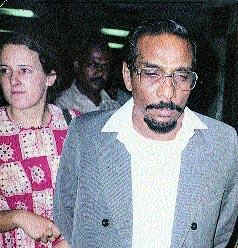
Adele and Anton Balasingam leaving India
Indian officials were waiting for a proper opportunity to take punitive action against the three. According to Adele Balasingham, they also anticipated India to show its displeasure by taking some punitive action. (See The Will to Freedom Page 102) She said they discussed the matter since the walkout from the Thimpu talks on 17 August. She said they were discussing at lunch on 23 August, the day the deportation order was served, that deportation was one possible Indian action. “Ironically, we had been discussing over lunch the possibility of us being deported as an option for the Indian Government,” she wrote.
Rajiv Gandhi invited the Sri Lankan delegation, which was enjoying a holiday at Thimpu after the walkout, to Delhi for talks with himself and other Indian officials. He later told Gulf News, in the above mentioned interview, the failure of the Thimpu talks were due to two main factors: failure to prepare a working paper which could have served as a basis for negotiations and the indiscipline of the Sri Lankan armed forces. He invited the Sri Lankan delegation to remedy the first defect. He wanted Hector Jayewardene and his officials to prepare a reasonable base for future discussions.
Hector Jayewardene, who flew to Delhi on 23 August, stayed there till 30 August and held a series of discussions with Rajiv Gandhi and his officials. At the first meeting, Rajiv Gandhi told the Sri Lankan delegation of the trip he had with President Jayewardene on 2 June to Dhaka, where the Sri Lankan President agreed to have the Provincial Council as the basic unit of devolution. Rajiv Gandhi told Hector Jayewardene, “We did not put that in writing as we felt that that was a matter for discussion between the Sri Lankan government and the Tamils.” He urged Hector Jayewardene to formulate a working paper with the Provincial Councils as the unit of devolution.
Delhi Accord
The Sri Lankan delegation and Indian officials negotiated for a week and worked out a working paper which was formally named ‘Draft Framework of Terms of Accord and Understanding.’ Later it came to be known as the Delhi Accord. Rajiv Gandhi called it “The Starting Paper” because he wanted it to serve as the starting point for further discussions.
Romesh Bhandari and Hector Jayewardene signed the Delhi Accord. Indian officials got the signatories to initial every page of the Accord. They did that because of their bad experience of dealing with President Jayewardene. Jayawardene had distanced himself from Annexure C, saying he did not sign it. He abandoned the June 2 understanding because it was not reduced to writing. In this instance Indians learnt that even their labourious effort to obtain the signature and initials from his own brother and Special Envoy did not tie down Jayewardene to the agreement.
The Delhi Accord was an advance over Annexure C. It accepted Provincial Councils as the basic unit of devolution. It provided for a limited increase in the powers to be devolved to the provinces. It also provided a safeguard for the Tamils by accepting that a committee of Tamil-speaking parliamentarians be set up under the constitution without whose consent legislation affecting Tamils could not become law.
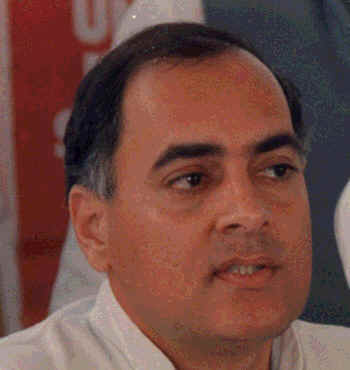
The Delhi Accord failed to meet the aspirations of the Tamil people in most of the basic matters. It did not provide for the merger of the north and east; thus it failed to meet the demand for a homeland. The powers were to be devolved to the Provincial Councils by parliament through legislation and not through constitutional amendment. Thus the parliament could withdraw those powers by passing laws with a simple majority – held by the Sinhalese parties. The power to determine national policies and the power to provide guidelines were retained by the central government. Though law and order would be a devolved subject, police officers would come under the national police service. The question of land and settlement were not clearly resolved. Many other areas, such as the relationship between the governor and the chief minister, and the courts and their structure, were left undefined.
While the talks on the Delhi Accord were going on in Delhi, serious developments took place in Sri Lanka and Chennai. In Sri Lanka, on 22 August the LTTE blew up an army jeep in Trincomalee killing four soldiers. Next morning, 23 August, in Chennai Balasingham told the reporters who had gathered in the LTTE political office at Adayar that Sri Lanka was not observing the ceasefire and added, “so we reserve the right to retaliate in defence of our people.”
Deportation
Balasingham’s statement served as the excuse for Indian Foreign Ministry officials to spring into action. Balasingham returned to his flat for lunch. Says Adele in her book, “It was a very hot day and Bala had gone for a brief nap. He had not long woken up, washed, and was preparing to go to the office for the evening when a cavalcade of police jeeps swooped on our flat.”
Adele has described in her book the scene that followed in graphic detail. The khaki-clad policemen jumped off their vehicles and sealed all exit points. A group of senior policemen led by Jumbo Kumar, Balasingham’s friend, climbed up the stair, knocked at the door, and told Balasingham, who opened the door, that he was to be deported. Balasingham was told that, since he was a British citizen and held a British passport, he would be put in the next flight to London. He was taken away under heavy police escort.
Adele says she took an auto rickshaw and sped to the political office. She told the senior cadres about the arrest. Pirapaharan was away in a training camp in northern Sri Lanka and he decided to stay there to prevent any punitive action against him also.
Adele says she waited at the political office for news about Balasingham. Since she was not informed about his whereabouts, she went to the police headquarters at Marina. She told the police that Balasingham needs a daily insulin injection. She was taken to her flat in a police car to collect the insulin. She was then taken to a private house in the outskirts of Chennai where Balasingham was detained. He was not harmed. He was well looked after. But the building was guarded by hundreds of policemen. Adele was told that that precaution was taken to prevent the LTTE from staging a daring rescue operation. Balasingham was put on the Air India flight to London on the next evening (24 August).
On his way to the airport, Balasingham requested permission to drop in at the LTTE political office. There he held a meeting with the senior LTTE cadres. He told them not to get upset about his deportation, but to make use of it as an opportunity to mobilize the people in Tamil Nadu and northeastern Sri Lanka. He told Adele to stay back in Chennai saying he would be back in a few weeks.
Satyendra and Chandrahasan of TELO were also deported. Satyendra, who held a British passport, did not resist and was sent in a separate Air India flight to London.

S.C. Chandrahasan 2012
Chandrahasan held a Sri Lankan passport, but had multi-entry visa to the United States. He was forced onto an Air Indian Airlines flight to Bombay. He performed a satyagraha during the flight, but was forcibly taken and put into an Air India flight bound for New York. He refused to alight at Boston to where the plane carrying him was diverted because of bad weather at New York. He demanded that he be taken back to Chennai. “I have done no wrong to India,” he protested. Indian High Commission officials who met him at Boston requested him to wait in the United States for two or three weeks with the promise to send him back. He declined. He was ultimately brought back to Bombay on 26 August. He refused to leave the airport demanding that he be taken to Chennai. He was allowed to return to Chennai after three days of high drama.
In Colombo, the government and the Sinhala media were elated. On 24 August, Anandatissa de Alwis, Minister of State and the government spokesman, welcomed India’s action. “We are very happy this has happened,” he announced with glee at a hurriedly arranged special press conference. He added, “India is beginning to realize who the disrupters of peace in Sri Lanka are.”
Euphoria swept through the Sri Lankan press. Deportation was the lead story and the topic of editorial approbation. The feeling that the government’s effort to drive a wedge between India and the Tamil militants had succeeded gained ground. Emboldened, President Jayewardene told a public meeting in the evening, “If it is peace, it is peace. If it is war, it is war.”
And it was war that he opted for. Two days later, on 26 August, the Special Task Force cordoned off the traditional Tamil village Thirukovil in the Ampara district and shot dead 26 Tamils. EROS, in a statement issued in Chennai, said they were all farmers in their fields. The LTTE retaliated the next day, 27 August, with a landmine attack near Trincomalee Naval Base on a navy jeep killing six naval ratings and a civilian woman employee.
Massive protests rocked northeastern Sri Lanka and Tamil Nadu, expanding and radicalizing the support base of the militants.
In Jaffna, on 27 August, Jaffna University students commenced a satyagraha campaign demanding the return of Balasingham to Chennai and the release of the 187 Tamil youths and women arrested under the Prevention of Terrorism Act and languishing in the Welikada prison without trial. “Bring back Bala Annai”, was the call to India and “Release Detainees or Charge them in Court,” was the demand for Sri Lanka.
Jaffna University students followed up the satiyagraha with a 7-day “Patha Yatra” (pilgrimage on foot). They marched in the third week of September through every village in the Jaffna peninsula. They rested the nights at prominent temples and churches where they staged street plays, villu paddu, kathapirasangam and paddi manram. By this time Jaffna’s traditional cultural tools had been transformed into effective mobilization mechanisms. The pada yatra turned the people against the Sri Lankan armed forces and the state.
The month-long protests brought almost all social groups onto the streets. Students boycotted classes; mothers of the Mothers’ Front took out processions; fishermen, cultivators, craftsmen, traders, teachers and unemployed youths organized their own marches. The support base of the militants was thus widened and deepened. And Tamil national feeling surfaced. I consider it a turning point in the history of the Tamil people of Sri Lanka. The Tamil people began to feel that they were no more a part of the Sri Lankan nation. They felt that they were a separate nation. Subsequent developments, straffing, shelling, bombing and ordering whole villages to leave reinforced in the Tamil psyche the sense of separate nationhood.
As a journalist who worked with Sinhala journalists for over 40 years, I must record that only one among that flock understood the significance and implication of that these protests. In the 15 September 1985 issue of Lanka Guardian Mervyn de Silva wrote in his column ‘Trends and Letters’ a single paragraph under the heading “Expanding Base.” He wrote, “In the last few weeks, protests in the North have assumed a new character which should be noted and, if it proves to be a new trend, studied for its possible implications.” Other Sinhala journalists and their political masters never took note of that warning.
By the end of 1985, the Jaffna population had been transformed from being supporters of the freedom struggle to participants. Children mounted watch outside the army camps. Perched on trees they signalled the public and the militants whenever army vehicles tried to leave the camp. The public acted instantly, barricading the roads with rocks, cement boulders and lighted tyres. The militants got ready for ambushws, to throw grenades, fire mortars and activate landmines. School students maintained information boards at public places taking information and messages from the militants to the public. People of all strata of society were involved.
A similar emotion of Tamil nationalism infected Tamil Nadu. Karunanithi’s DMK and its allies took the lead. Within 48 hours of the deportation orders, the Tamil Nadu opposition took to the streets. Karunanithi led a massive procession along the busy streets of Chennai denouncing Rajiv Gandhi and President Jayewardene for harassing and killing Tamils. “Down with Rajiv Gandhi,” “Down with President Jayewardene,” “Down with betrayers of Tamil Eelam” they shouted. Tamil Nadu was plastered with posters “Down with Rajiv Gandhi.”
D
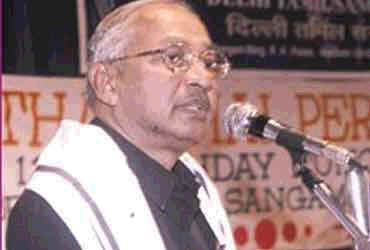
K. Veeramani, 2004
ravida Kazhagam leader K. Veeramani was cheered lustily when he accused MGR of being a party to the deportation of the three Tamil militant leaders.
And there was standing ovation when Veeramai threatened, “If the orders are not withdrawn Gandhi will face agitations like Punjab and Assam and we will not allow any North Indian to set foot here.”
MGR could not keep out of the emotional wave that swept Tamil Nadu unifying the people. Nor could Rajiv Gandhi’s own Congress Party keep aloof. They were also drawn into it. There were daily demonstrations; meetings.
The protest peaked in the third week of September. The Tamil Eelam Supporters Organization (TESO) conducted a massive demonstration crippling the entire state. MGR countered it on 24 September with his own show of support for the Sri Lankan Tamils.
MGR organized a gigantic 12-hour satyagraha beginning at 6 am at Marina Beach and at all major cities in Tamil Nadu on 24 September. MGR participated in the Marina satyagraha and thousands of his party members and fans joined him. At Chenkalpattu, Anna Dravida Munnetta Kazhaham propaganda secretary Jayalalitha headed the big group of fasting supporters.
MGR also organized a donation campaign at the Chief Minister’s office at the Tamil Nadu Secretariat. He started the fund with a donation of 2000 rupees. He was moved when the president of the Government Employees Union announced the decision of its one million members to donate a day’s pay. He went up to the microphone and shouted “Thamil Vazhha“, “Thamilar Vazhha” and Eelath Tamilar Velha“. (Long live Thamil, Long live Tamil People, Victory to the Tamil people of Eelam).
In Jaffna, school and university students staged a fast at temples and churches in the peninsula on that day and took a massive procession to the Jaffna secretariat. They handed a petition addressed to the President of Sri Lanka to the Government Agent. The petition called upon the government to release all the people held in custody under the Prevention of Terrorism Act. While the Government Agent was receiving the petition, a few youths hoisted the LTTE flag over the Jaffna Secretariat.
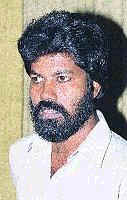
K. Padmanabha
The upsurge of Tamil feeling in Sri Lanka’s northeast and in Tamil Nadu infected the entire Tamil population worldwide. The Tamil diaspora was jolted into action. Support for the Sri Lankan Tamils was orchestrated in different forms in different cities of the world – meetings, resolutions, demonstrations, petitions, contributions.
While the Tamil community was getting radicalized worldwide, Delhi and Colombo continued their political chess. In Delhi, Rajiv Gandhi initiated action to build on the Delhi Accord. He invited the leaders of the six Tamil groups that participated in the Thimpu talks for a meeting with him and his officials. RAW officials were able to get to the leaders of the TULF and PLOTE. Pirapaharan and Sri Sabaratnam had gone underground and the other two – Balakumar and Pathmanabha – told RAW they were unable to do anything without Pirapaharan and Sri Sabaratnam, the active and bigger of the four militant groups that constituted the ENLF.
Foul killings
The TULF and PLOTE accepted Rajiv Gandhi’s invitation. Two days later, on 2 September, two prominent former TULF Members of Parliament who opted to stay in Jaffna after the 1983 riots were killed. A group of youths knocked at the door of Alalasuntharam’s home at Kalviyankadu, in a by-lane on the Jaffna-Point Pedro road. He opened the door. “Annai! We want to discuss an important matter. Come with us,” they told him. He went in, put on a shirt and went out with them. His body was found next morning in a thicket near his home with two wounds on his forehead.

Visvanather Dharmalingam pasting TULF posters with Mrs. M. Amirthalingam in 1972
Another group of youths took away Dharmalingam around the same time. His body was found next morning near a cemetery. There were bullet marks on his forehead.
Similar handwritten notes were found near both bodies. The notes said that their death was punishment for the betrayers from the TULF. They were signed ‘Tamils with Self Respect.”
The murders, especially that of Dharmalingam sent shock waves throughout Sri Lanka, India and the world. Dharmalingam was a respected politician. He was rich, loved and a socialist by conviction. He was an important member of the Soviet-Lanka Friendship Society. He was responsible for the socialistic tint of the otherwise capitalist and feudal TULF.
Alalsuntharam was my schoolmate. He was younger to me. I knew Dharmalingam from 1957 when I joined Lake House and started reporting parliament for the Tamil daily Thinakaran. I wish to record an incident that happened at the old Parliament building. I was with Dharmalingam at the library in the second floor. We entered the lift to go down to the ground floor for tea at the Parliamentary canteen. Opposition Leader Jayewardene was in the lift with another Member of Parliament when we entered it. The MP turned to Jayewardene and said, “Sir! Do you know Dharma is the richest man in Jaffna.” Jayewardene smiled and said, “No wonder he speaks socialism.”
Dharmalingam had a hearty laugh. I related this incident to Dharmalingam’s son, Siddarthan, PLOTE delegate to the Thimpu talks and the present leader of PLOTE, a few years later. Siddarthan said his father had told the incident to the family.
The murders of the two popular parliamentarians generated a swell of sympathy and massive crowds attended their funerals. The Jaffna public and Sri Lankan police and intelligence agencies blamed the LTTE for the murder. People knew that the LTTE had been critical of Alalasuntharam for some time. Alalasuntharam was accused of misdeeds at the Jaffna Multipurpose Cooperative Society which he headed. The LTTE had shot him on his foot as a warning. And it was also public knowledge that Pirapaharan was critical of the TULF for the role it was playing as the negotiator for the Tamil people.
Pirapaharan’s criticism of the TULF had mounted in mid-1985. He had censured Amirthalingam for advocating Indian military intervention to prevent army attacks in the northeast. Pirapaharan issued a highly critical statement in which he charged TULF leaders of political bankruptcy. The statement, issued in June just before the ceasefire came into operation, portrays Pirapaharan’s irritation towards the TULF.
This is the translation of the statement issued in Tamil:
We are in this sad plight because our parliamentary leadership lacked the capacity and political sagacity to gauge the enemy.
Our parliamentary leaders continued to cling to their parliamentary seats and persisted in extolling the rulers to obtain small favours even after state terrorism sharpened its claws and the racist devil started destroying our race.
The next major mistake the TULF leadership committed was its attempt to marginalize the emerging new generation of armed freedom fighters. The TULF leaders failed to understand the historical necessity and the importance of the armed struggle to which we have committed our lives. They called us extremists and terrorists.
All they did was to conduct talks using the armed struggle as a pressure mechanism to obtain political concessions.
They fail to understand that we must fight and win our independence. They lack self confidence. That is why they are inviting the Indian army to invade our country.
We need India’s help. We need Indian support. We need India’s goodwill.We must persuade India to support our demand for a separate state for ourselves.
We should ask India to accede to our demand for self-determination.
We must tell India that an independent state of Tamil Eelam is the only solution to our problem.
Without doing these things, begging India to intervene and find a solution to our problem would not be political wisdom.
I think only the Jaffna daily Eelanadu carried this statement on an inside page. The Colombo media ignored it.
The Jaffna public and the Sri Lankan police blamed the LTTE for the murder of the two TULF parliamentarians. Speaker after speaker berated the LTTE, mostly indirectly, in their funeral orations.
Sri Lanka and India expressed shock and distress. Rajiv Gandhi told the media, “Certain Tamil extremists were killing other Tamils.” He did not put the blame directly on the shoulders of the LTTE. Sri Lanka, especially the Colombo media, went all out to blame the LTTE for the murders.
Jayewardene launched a massive propaganda campaign to discredit the Tamil armed struggle. He branded the Tamil liberation organizations as “terrorist groups that want to destroy democracy.”
Athulathmudali went a step further. He called the LTTE ‘a murderous group.’ He prepared the ground for Jayewardene to wriggle out of the Delhi Accord which had run into stiff opposition from the SLFP and Buddhist clergy. Prominent Buddhist priests and Sinhala organizations formed during that period a new grouping called the National Front to protect the Sinhala race and the country. SLFP leader Sirimavo Bandaranaike also joined the grouping.
The Sinhala press, as usual, had kindled Sinhala fears that the Provincial Councils would usher in federalism and ultimately result in the division of the country.
Wriggles Out
Jayewardene placed the Delhi Accord before the cabinet on 4 September, though it was not listed in the agenda. Premadasa spoke against the Provincial Councils. Lalith Athulathmudali warned the environment in the country was not conducive to a discussion about a political solution. The other hardliners in the cabinet joined the chorus of protest.
Jayewardene summoned Dixit to his residence at Ward Place in the evening and told him that the murders of democratic politicians in Jaffna had altered the political environment in Sri Lanka. The Sinhala people were angry. They wanted the government to finish off terrorism before resuming the effort toward a political settlement. He said that the cabinet and the parliament were not prepared to approve the document his younger brother and special envoy had signed in Delhi. He said the constitutional and administrative framework suggested in the document and the extent of the powers that would have to be devolved would violate the unitary character of the existing constitution and pave the way for the division of the country. Later in the day Foreign Minister Hameed conveyed to Dixit the same decision of Jayewardene.
Rajiv Gandhi was upset over it and summoned Dixit to Delhi for consultations. Dixit, who was in Delhi for a week, 7-14 September, had a series of meetings with Romesh Bhandari and a lengthy meeting with Rajiv Gandhi.
Dixit returned to Colombo with the message that Jayewardene should continue the attempts to improve on the package so that it could be discussed in December at Dhaka where Rajeev and Jayewardene would meet in December during the inaugural sessions of the South Asian Association for Regional Cooperation (SAARC). Jayewardene had succeeded in winning more time to continue his military option.
Sri’s Boys
Pirapaharan surfaced from hiding on 10 September to attend the special meeting of the ENLF leaders called to decide about accepting Rajiv Gandhi’s invitation for a meeting. India was desperately wanting a meeting with the ENLF leaders because the 3-month ceasefire would lapse on 18 September.
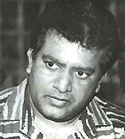
V. Prabakaran
At that meeting Balakumar told Pirapaharan that people were talking that his boys had shot the two TULF parliamentarians.
Pirapaharan replied with his usual smile, “They also say Sri’s boys did it.”
Sri Sabaratnam who heard it denied their involvement. “No, our boys did not do it,” he said.
But it was Sri Sabaratnam’s boys who committed that murder. They did it on Sri Sabaratnam’s orders. The order was given in Tamil: Irandu koodanikararukku mandaiyil podungal (Shoot two TULF men on the head). The order was given to Das. He dispatched two groups to do the job.
The PLOTE sentry outside Dharmalingam’s residence later identified the vehicle used for the killing. Dharmalingam’s son and PLOTE’s delegate at the Thimpu talks was careful not to blame the LTTE for the murder. In his statement from Chennai he said, “one of the groups in the ENLF was responsible.”
The ENLF issued a statement denying responsibility. The statement condemned the killings. TELO was one of its signatories.
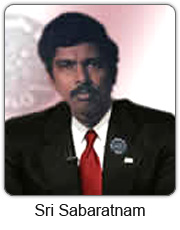 The motive for Sri Sabaratnam’s order is still a mystery. Theories abound. One said he did it on the bidding of an intelligence agency. Another said, it was intended as a punishment to the TULF for agreeing to talk to Rajiv Gandhi in the absence of the ENLF. The third was that he wanted to discredit the LTTE by putting the blame on it.
The motive for Sri Sabaratnam’s order is still a mystery. Theories abound. One said he did it on the bidding of an intelligence agency. Another said, it was intended as a punishment to the TULF for agreeing to talk to Rajiv Gandhi in the absence of the ENLF. The third was that he wanted to discredit the LTTE by putting the blame on it.
Whatever the motive, the Sri Lankan government benefited from the murders. In addition to wriggling out of the Delhi Accord it launched a military onslaught. That very evening, 2 September, the army used its newly acquired helicopters to strafe the scene of the guerrilla attack on a truck carrying food supplies to the soldiers in the Point Pedro camp. Six civilians died and several other were injured.
The Point Pedro helicopter strafing signalled a new turn in the war. The security forces, which were steadily losing their mobility on the ground, were turning to the air to maintain their superiority. During late 1985 the government used its Air Force to bomb suspected guerrilla hideouts.
On the ground the militants continued to gain ground and strength. On 2 September night well- armed militants pounded Eravur police station in eastern Batticaloa district with bombs, mortars, RPGs and machine guns, killing seven and wounding 12 policemen.
Terror in Trinco
Two days later, 4 September, violence erupted in Trincomalee. The army had by that time introduced a route clearing procedure before the movement of army vehicles. A company of soldiers walk along the road checking both sides, culverts and bridges for buried landmines. Commodore Justin Jayasuriya of the Sri Lanka Navy, who coordinated the military operations in the Trincomalee district, called that a labourious task. He told foreign correspondents, “Our soldiers should check every foot of the road before we send out our convoy of vehicles.” On 4 September a company of soldiers walking in files on either side of the road stepped on a landmine hidden in a heap of dried leaves. Three men died on the spot. The militants who were hiding behind a shrub fired at the others, wounding four.
The combined armed forces – army, navy and the paramilitary Home Guards -, backed by Sinhala thugs, unleashed a brutal attach on the Tamils living in the Trincomalee town and the surrounding villages that night. Several Tamil houses in the town were burnt down. TULF leader R. Sampanthan’s house was specially targeted and attacked on 9 September.
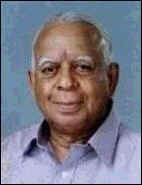
R. Sampanthan, 2004
The Defence Ministry in Colombo blamed the LTTE for the attack on Sampanthan’s house. The LTTE denied involvement, calling the attack a conspiracy. Sampanthan told me when I met him later that month in Colombo that his relatives had seen soldiers throwing bombs at his house.
Sampanthan told me that 9 September night was a night of terror for the people of Trincomalee. Gun shots and loud explosions were heard throughout the night. Soldiers patrolled all roads threatening to shoot if anyone stepped out. Thugs were roaming from house to house throwing grenades and petrol bombs.
The Hindu published a story on 22 September about the attacks on the Tamils of the Trincomalee district under the headline, 52 TAMIL VILLAGES IN TRINCOMALEE DISTRICT RAZED TO THE GROUND IN TWO MONTHS. It was a rewrite of separate reports filed by the Indian news agencies Press Trust of India (PTI) and United Press of India (UNI) which stationed its correspondents in Colombo.

P. Jayaram 2021
The first part of the story was a report by the PTI correspondent (I knew him but forget his name) who interviewed persons who fled Trincomalee. The second part was by the UNI correspondent P. Jayaram. His report was an interview with Sampanthan.
The Hindu story reads:
Fifty two villages have been destroyed in the Trincomalee district in the last two months by the Sri Lankan armed forces according to an eyewitness who fled the country. The middle aged person who claims that he was helped by the Sri Lankan Government to escape from Trincomalee, told PTI many shops and houses in the district had been razed to the ground rendering thousands of Tamils homeless in the Government’s bid to “drive away Tamils from the strategic port town of Trincomalee”.
The person, a non Tamil belonging to a group settled in Trincomalee for generations who wanted to be anonymous said he fled from the town following the ghastly attack by the Sri Lankan Home Guards on September 4 in Trincomalee town. Virtually, the entire town was wiped out in the attack driving away the Tamils to forests and refugee camps, he said. About 12 temples and a mosque were destroyed in the attack and Pattam Kurchi, a nearby village was completely wiped out. The person with religious pursuits said he decided to get away from the town as it had become “unlivable’.
Although he could not give any statistics about the casualties, he said, all he knew was there were 6,000 refugees lodged in a school turned camp after the Sept. 4 attack in Trincomalee. The entire area had become “unsafe” to travel and communication links had been completely cut off.
He said the modus operandi the troops adopted was to come in disguise to a targeted place and throw some bombs. They would then come back to the area a little later saying the Liberation Tigers had attacked the place, and so they must search and apprehend them…. The person said it was wrong to say that the Tamils attack first and the Sinhalese Army undertook reprisals. “It is the (Sri Lankan) Army and the Home Guards who throw bombs and then blame the Tigers for it.” He said during the Sept. 9 incident, in which the former TULF MP, Mr. Sampanthan’s house was bombed at midnight in Trincomalee, “people had seen Sinhalese come and bomb the place with their own eyes.”..
“The Sri Lanka Government has accomplished its objective of a ‘prohibited zone’ by driving out Tamils from the 40 mile North Eastern coastal stretch from Mullaitivu to Trincomalee town in the island, through savage attacks on them jointly by the Sri Lankan army men and armed Sinhala hoodlums”, Tamil United Liberation former politburo member and former MP from Trincomalee, R. Sampanthan said today.He said systematic attacks on Tamils were launched during the last three months in the coastal village of Kuchuveli, Nilaveli, Uppuveli, Murugapuri, Tirucuddalore, Veeranagar and division No. 10 in Trincomalee town. Mr. Sampanthan said the efforts of affected Tamils to reach these areas were resisted by the Sinhala armed forces and home guards. Three Tamils were hacked to death when they attempted to reach their hometown in Murugapuri two days ago, he added.”
Next: Chapter 41. Pirapaharan meets Rajiv Gandhi
To be posted April 1
###